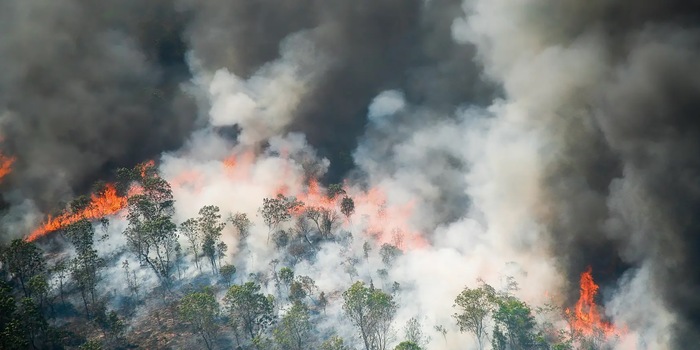
Forest fires on the rise worldwide
For decades, the number of forest fires and the area burnt decreased. However, the trend seems to have reversed - due to climate change and changes in land use.
The fire season in the northern hemisphere is not yet over, but one thing is already clear: in the USA and Canada, this year was the year with the most victims and the worst fire year in decades. On the island of Maui, well over 100 people died when a bushfire devastated the town of Lahaina. And in Canada, around four per cent of the total forest cover has burned since the beginning of the year - more than 150,000 square kilometres. However, these dimensions fit into a trend that scientists have been observing since the turn of the millennium. After decades of declining numbers and areas of wildfires, they are on the rise again. This is reported by Alexandra Tyukavina from the University of Maryland in College Park and her team in "Frontiers of Remote Sensing".
Compared with the time around the year 2000, twice as much forest burns each year today (six million hectares). Overall, forest fires account for a quarter to a third of the total forest loss per year - the rest is due to deforestation or pest infestation. In the study period up to 2022, 2021 was particularly bad, with over nine million hectares falling victim to the flames.
The boreal regions and, until 2022, especially the large coniferous forests of Siberia were particularly affected (the 2023 fire season, with Canada as a global focus, was no longer part of the study). Although fire is part of the natural cycle in this ecosystem, the area affected has been steadily increasing by three per cent annually since 2001. The working group attributes this to a large extent to the strong warming and increasing droughts in the region: the boreal north is heating up faster than the rest of the world. This extends the fire season and increases the intensity of fires. In 2021 alone, 5.4 million hectares of forest were lost in Russia as a result.
However, the number and extent of forest fires also increased in other parts of the world, especially in the tropics, subtropics and temperate regions of Australia, where the 2018/19 season went down in history as the "black summer". According to Tyukavina and Co., the increase in the humid tropics, where forest fires are extremely rare naturally, is also remarkable. However, the annual increase over time was five per cent or 36,000 hectares.
These were mostly fires that spread from cleared areas to intact forest areas. In order to create new pastures for cattle, landowners first remove the large trees from the forest, destroy the rest and then set fire to the material during the dry season. This is why actual forest fires were "only" responsible for 10 per cent of the rainforests destroyed in the last 20 years, while 90 per cent were due to other causes, which then fuelled the fires. Climate change, more frequent droughts and disruptions to the small water cycle caused by the fragmentation of forest areas are also fuelling the fires.
The observed trend also applies to Europe, not only around the Mediterranean, but also in temperate parts of France and in parts of Germany, where the number and area of forest fires is increasing. Around the Mediterranean, climate change with increased droughts is playing a role, as is the significant change in land use in recent decades. Areas kept open by arable and livestock farming have quickly reverted to scrub and woodland following the abandonment of agriculture; in addition, there is afforestation with eucalyptus and pine trees, which can burn quickly and intensively, as has happened in recent years in Portugal and the northern Spanish province of Galicia.
In the meantime, the development in the forests shows the exact opposite trend as in the savannahs and grasslands of the world. They account for around 70 per cent of the area destroyed worldwide. However, the total area burnt has been significantly reduced in recent decades, particularly in Africa, but also in Australia and South America. In addition to improved fire protection, this is mainly due to changes in agriculture. Huge areas have been converted from grassland to arable land and are used to grow grain or soya, which reduces the risk of fire.
There is another crucial factor to consider when it comes to forest fires. Climate change and changes in land use favour fires. However, for a fire to actually start, it usually takes someone else to start it - either deliberately or accidentally: In the USA, more than 80 per cent of forest fires are probably caused by people lighting fires, throwing their cigarettes into the dry undergrowth or not looking after their campfires properly. The figures are likely to be similar in Europe and probably even higher in the humid tropics. Only a minority of fires can be attributed to natural causes such as lightning.
Spectrum of science
We are partners of Spektrum der Wissenschaft and want to make well-founded information more accessible to you. Follow Spektrum der Wissenschaft if you like the articles.
[[small:]]
Cover image: © J Brarymi / Getty Images / iStock (detail) The Amazon region was long one of the regions where fires were rare. But cattle breeders and soya farmers are now regularly starting fires.
Experts from science and research report on the latest findings in their fields – competent, authentic and comprehensible.